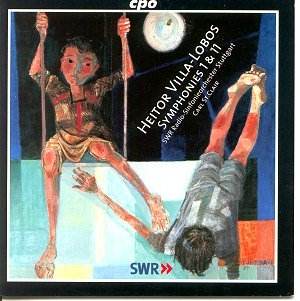HEITOR VILLA-LOBOS (1887-1959)
Symphony No. 1 The Unexpected (1916) 26.06
Symphony No. 11 (1955) 26.04
 rec 15-19 Sept 1997 Stuttgart
SWR RADIO SO, Stuttgart / Carl St Clair
rec 15-19 Sept 1997 Stuttgart
SWR RADIO SO, Stuttgart / Carl St Clair
 CPO 999 568-2
[52.15]
CPO 999 568-2
[52.15]
Crotchet
Amazon
UK

You naturally associate Villa-Lobos with the sequence of Choros and
Bachianas Brasileiras and with the Amazonian jungle. Well I do anyway.
Symphonies? Hardly! Although No. 4 was always there, in splendid isolation,
in the colossal Pathé-Marconi Villa-Lobos edition (long available
on both LP and CD). I reviewed the Marco Polo recording of No. 6 back in
1998.
In fact there are twelve symphonies spanning the whole of the composer's
creative life. They are not evenly distributed across the years. The first
five were written between 1916-1920. The sequence resumes with No. 6 in 1944
and then continues until the late 1950s and his death in 1959.
The First is a romantic torch of a piece. Strings screech and pulse in the
first movement in echo of Taras Bulba and Hanson's heroic Nordic
Symphony. There is a touch of Hollywood there as well. Those flashing birdsong
flutes are pure Hanson! Alongside such technicolour influences you can also
detect the sweep of Ravel's Daphnis and Debussy's La Mer. Romance
is also the cornerstone of the second movement with its cello-invocation,
pizzicato, growling bass and big tune itself an apparent refraction of Sibelius
symphony No. 1. After a third movement (rapidly rhythmic, slightly jazzy,
jungle-souled, nervous and richly harp-swirled) we return to the great romantic
theme from the first movement ultimately wiped out by a massive smoothly
affirmative dying away.
The penultimate symphony was premiered by the Boston SO and the composer
on 2 March 1956. It powers forward with the massy nuclear plant energy of
an Igor Markevich score. The Largo is slightly apocalyptic - a floating Ravelian
world. Villa-Lobos seems never to have been short of quick-footed fantastic
invention and it shows time after time in a chivvying and stabbing quick
march. The bell carillons of the finale are slammed downwards by the brass
section. The movement has the fire-hose energy of Alwyn 4. The score vibrates
richly with the vibraphone, xylophone, matraca (clatter), celesta, two harps
and piano. Great bass shudders run and slither primevally through the score.
In fact the music sounds very much like Malcolm Arnold in the plaintive flute
voice at 2.40 (IV). All ends in a climactic brassy sunburst.
Well if this carries on we can expect complete symphonic cycles of Alan
Hovhaness, Niels Viggo Bentzon, Arthur Butterworth, Walter Stanley Gaze Cooper,
Peter Tahourdin, Peter Racine Fricker (now when is someone going to record
his choral masterpiece The Vision of Judgement?), Alan Bush, Maximilian
Steinberg, Lev Knipper, Lokshin (his third, a setting of Kipling poems, is
a very strong work) and Yuri Shaporin (now please add your own names).
So, to return to Villa-Lobos, here is your chance to be in at the beginning.
This series will clearly be worth collecting and will redeem considerable
satisfaction musically speaking. Two emotionally juicy symphonies of an epic
nature despite their comparative brevity.
Reviewer
Rob Barnett

